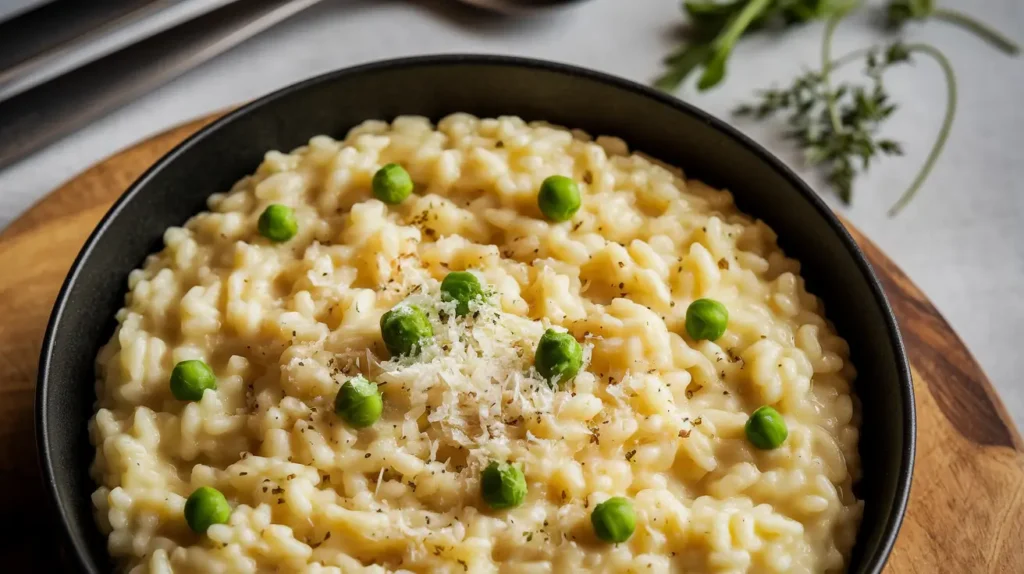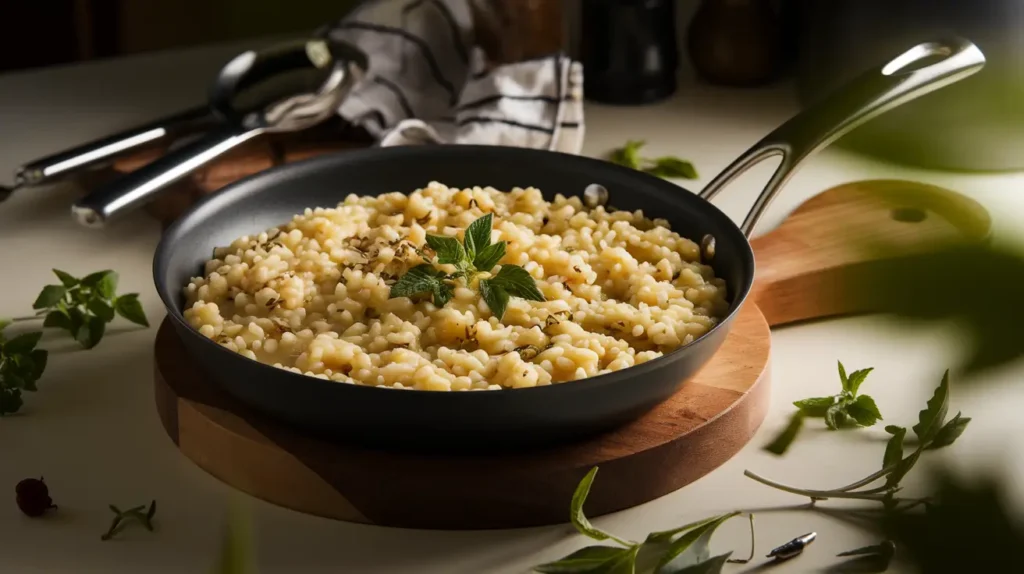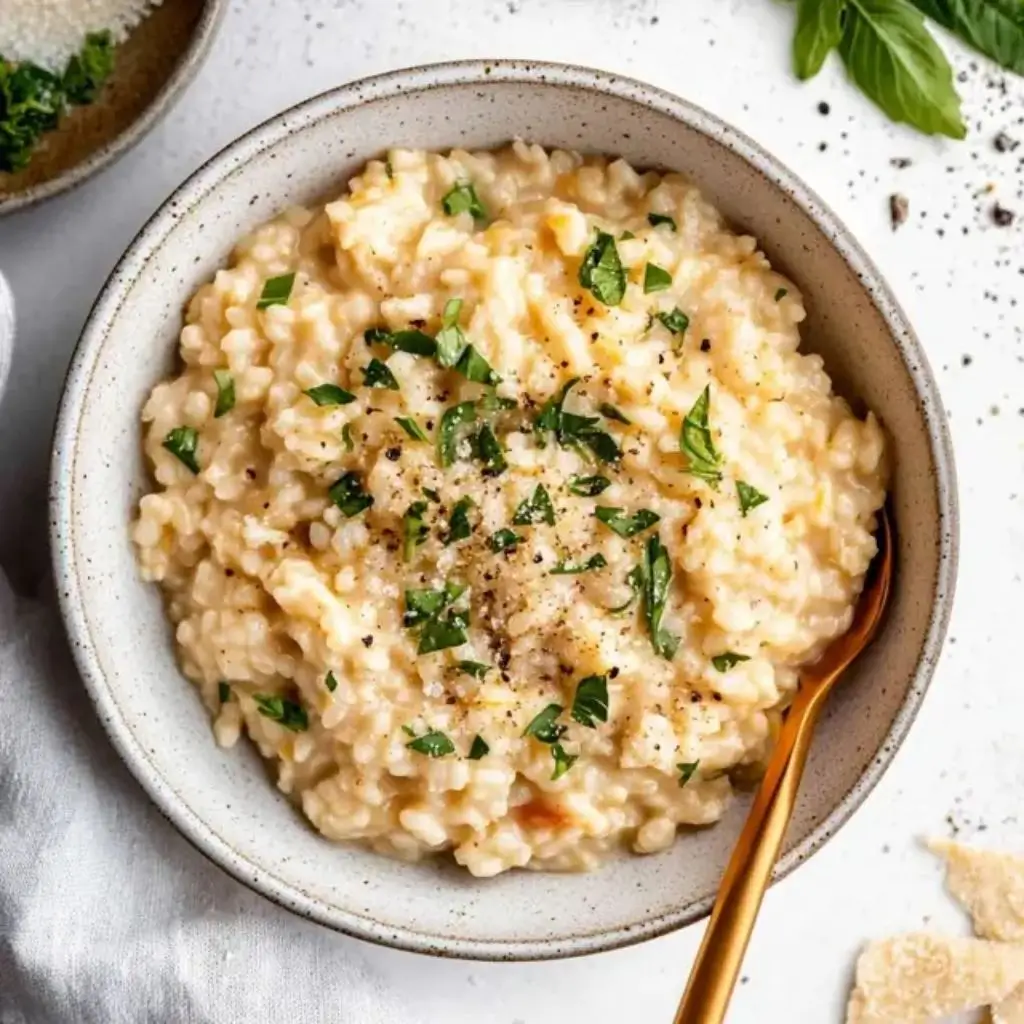Table of Contents
Risotto, a creamy and comforting Italian rice dish, is a favorite among food lovers worldwide. Yet, for those following a gluten-free diet, questions often arise about whether it’s truly safe to eat. After all, gluten can sometimes sneak into even the most natural dishes due to cross-contamination or hidden ingredients. So, is risotto gluten free?
The good news is that traditional risotto made with the right ingredients is naturally gluten-free. The key is understanding what to include and what to avoid to make it safe for gluten-sensitive individuals or those with celiac disease. Whether you’re a risotto enthusiast or a curious home cook, this guide will cover everything you need to know, from choosing safe ingredients to creating a creamy gluten-free risotto in your kitchen.
What is Risotto?
Risotto is a classic Italian dish made with short-grain rice varieties like arborio or carnaroli. These rice types are prized for their ability to absorb liquid while slowly releasing starch, creating risotto’s signature creamy texture. Unlike regular rice dishes, risotto requires a gradual cooking process, where warm broth is added in stages and frequently stirred to develop its rich consistency.
At its core, risotto is gluten-free, as rice itself does not contain gluten. However, factors such as store-bought stocks, added ingredients, or cross-contamination can introduce gluten, which is something to be mindful of when preparing a gluten-free version.
💡 Many people confuse risotto with pasta due to its creamy consistency. If you’re wondering whether risotto is rice or pasta, this guide breaks down the key differences.
Why Gluten-Free Diets Are Important
For individuals with celiac disease or gluten intolerance, consuming gluten—commonly found in wheat, barley, and rye—can trigger severe digestive issues, fatigue, and long-term health complications. Even a small amount of gluten, from cross-contamination or overlooked ingredients, can cause significant discomfort.
This is why following a gluten-free diet isn’t just about preference—it’s about well-being and health. Thankfully, with careful planning and preparation, dishes like gluten-free risotto can be enjoyed safely and without compromising taste or texture.
For those who love Italian cuisine but are worried about gluten, risotto offers a delicious and versatile option for dinner. Just a few mindful choices in ingredients can make all the difference!
Is Risotto Gluten Free?
Here’s the big question: Is risotto gluten free? The short answer is yes—if made with the correct ingredients. Traditional risotto recipes rely on natural, gluten-free components such as:
- Short-grain rice (arborio, carnaroli, or vialone nano)
- Broth or stock (homemade or gluten-free certified)
- Butter and cheese (like Parmesan, which is naturally gluten-free)
- Fresh vegetables, meats, or seafood
That said, gluten risks may arise when using store-bought broths, pre-mixed risotto packages, or ingredients contaminated with gluten. In these cases, it’s essential to double-check labels to ensure they are certified gluten-free.
Additionally, cooking tools or surfaces that previously handled gluten-based foods could contaminate a gluten-free dish. So, cleanliness and ingredient selection are critical when preparing risotto for those avoiding gluten.
Understanding Gluten in Risotto
For anyone following a gluten-free diet, understanding the nuances of your favorite dishes is key to ensuring they remain safe and delicious. Risotto, known for its creamy and rich texture, naturally seems like a gluten-free dish, but there are factors to consider before taking that first satisfying bite. From arborio rice to additional ingredients and cooking practices, let’s explore how gluten plays a role in risotto.
Is Risotto Naturally Gluten Free?
The foundation of any good risotto is the rice. Fortunately, rice itself is naturally gluten-free. Short-grain rice, such as arborio, carnaroli, or vialone nano, is the most commonly used for making risotto due to its high starch content, which gives the dish its signature creaminess.
Is Arborio Rice Gluten-Free?
Yes, arborio rice is naturally gluten-free. As a pure rice variety, it doesn’t contain gluten and can be enjoyed safely by those with gluten intolerance or celiac disease. The same applies to other short-grain rice types like carnaroli and vialone nano.
However, it’s essential to be vigilant when purchasing rice. In some cases, cross-contamination can occur during processing, packaging, or storage, particularly if the rice is processed in facilities that handle gluten-containing grains like wheat or barley. To stay safe:
- Look for certified gluten-free labels on rice packages.
- Purchase rice from trusted brands that follow strict gluten-free protocols.
Are All Types of Rice Naturally Gluten-Free?
Yes, all unprocessed, natural rice varieties—white, brown, black, or wild rice—are inherently gluten-free. However, just like arborio rice, the risk of gluten contamination arises during processing or if rice mixes contain seasonings with gluten-based ingredients. Stick to plain rice varieties and double-check ingredient labels to ensure your risotto remains gluten-free.
Common Risotto Ingredients and Gluten
While rice is naturally gluten-free, other risotto ingredients can introduce gluten if you’re not careful. Here’s a breakdown of common risotto components and what to watch for:
Gluten-Free Ingredients:
- Rice: As discussed, arborio, carnaroli, and vialone nano rice are all gluten-free.
- Broth or Stock: Homemade broth made from vegetables, chicken, or beef is naturally gluten-free. For store-bought options, check labels to ensure they’re certified gluten-free. Some broths may contain gluten-based thickeners or flavor enhancers.
- Butter and Cheese: Real butter and cheeses, such as Parmesan or Pecorino Romano, are naturally gluten-free. Avoid processed cheese sauces or grated cheese with anti-caking agents unless labeled gluten-free.
Potential Gluten Risks in Store-Bought Broth or Packaged Risotto
Pre-packaged risotto mixes and commercial broths can be tricky. Many store-bought risotto products contain additives, seasonings, or thickeners derived from gluten. Additionally, pre-made risotto may be processed alongside gluten-containing foods. To minimize risk:
- Always read ingredient labels carefully.
- Opt for brands that clearly state gluten-free certification.
- When in doubt, prepare your own broth and risotto at home for full control over ingredients.
How Cross-Contamination Can Happen
Even if you use gluten-free ingredients, cross-contamination can compromise the safety of your risotto. This happens when gluten-free food comes into contact with gluten particles during preparation or cooking. Here’s where it commonly occurs:
Kitchen Tools and Surfaces
Shared kitchen tools—like cutting boards, wooden spoons, and colanders—that were previously used for gluten-containing foods can transfer gluten to gluten-free risotto. To avoid this:
- Use separate utensils, pots, and pans when cooking gluten-free dishes.
- Thoroughly clean surfaces, including countertops, knives, and spoons, before preparing gluten-free risotto.
Cooking in Restaurants vs. at Home
Dining out can be a challenge for gluten-free eaters, as restaurant kitchens often handle gluten-containing foods alongside gluten-free options. For risotto, cross-contamination may occur when:
- The same pot or spoon is used to stir both gluten-free and regular risotto.
- Non-gluten-free broth or ingredients are used in your dish.
To stay safe when dining out:
- Ask the chef or server to confirm that gluten-free ingredients and clean tools are used to prepare the risotto.
- Choose restaurants that explicitly offer gluten-free menu options or follow safe food-handling practices.
By understanding these potential risks and practicing caution, you can enjoy a delicious, creamy risotto without any worries.
How to Make Risotto Gluten Free
The beauty of risotto lies in its simplicity, and the good news is that making it gluten-free doesn’t require much effort. With a few mindful ingredient choices, you can enjoy a rich, flavorful dish that fits perfectly into a gluten-free lifestyle. Let’s dive into everything you need to know about creating the perfect gluten-free risotto.
Gluten-Free Risotto Ingredients

To ensure your risotto remains gluten-free, focus on high-quality, natural ingredients and certified gluten-free products:
- Gluten-Free Rice: Use short-grain varieties like arborio, carnaroli, or vialone nano for the best results. These rice types absorb broth well and release starch for that creamy texture.
- Gluten-Free Broth and Stock: Opt for homemade stock or check store-bought labels for gluten-free certification. Vegetable, chicken, or beef stock works well.
- Parmesan and Other Gluten-Free Cheeses: Authentic Parmesan cheese is naturally gluten-free. Avoid pre-shredded varieties unless labeled gluten-free, as anti-caking agents may contain gluten.
- Gluten-Free Alternatives: For non-dairy or vegan risotto, replace butter with olive oil or vegan margarine and use nutritional yeast or cashew cream instead of cheese.
Step-by-Step Gluten-Free Risotto Recipe

Ingredients:
- 1 cup gluten-free arborio rice
- 4 cups gluten-free vegetable or chicken broth
- 2 tablespoons butter (or olive oil for vegan)
- 1 small onion, finely chopped
- 1 clove garlic, minced
- 1/4 cup gluten-free Parmesan cheese (or nutritional yeast for vegan)
- Salt and pepper to taste
- Fresh parsley for garnish
Instructions:
- Heat the gluten-free broth in a pot and keep it warm over low heat.
- In a large pan, melt butter (or olive oil) over medium heat. Add chopped onions and garlic, cooking until soft and translucent.
- Add the gluten-free arborio rice and stir for 1–2 minutes, ensuring each grain is coated in the butter or oil.
- Gradually ladle in warm broth, one scoop at a time. Stir frequently, allowing the rice to absorb the liquid before adding more.
- Continue this process for 18–20 minutes until the rice is tender and creamy. Adjust seasoning with salt and pepper.
- Stir in Parmesan cheese (or nutritional yeast) and a small pat of butter for extra creaminess.
- Garnish with fresh parsley and serve warm.
Tips for Making the Creamiest Gluten-Free Risotto
- Stirring Technique: Stir consistently to release starch and create a creamy texture. However, avoid over-stirring to prevent gummy rice.
- Broth Temperature: Always use warm broth—cold liquid can shock the rice and alter the cooking process.
- Ideal Cooking Times: Arborio rice typically takes 18–20 minutes to achieve the perfect al dente texture. Taste as you go to ensure it’s cooked just right.
Variations of creamy risotto
Mushroom creamy risotto:
Saute mushrooms in olive oil with garlic and add them to the risotto for an earthy, savory twist.
Vegan creamy risotto:
Replace butter and cheese with olive oil and nutritional yeast. Add roasted vegetables like zucchini or butternut squash for flavor.
Chicken and Vegetable Gluten-Free Risotto:
Stir in cooked chicken pieces and fresh vegetables such as peas or spinach for a hearty, protein-packed meal.
With these variations and tips, making creamy risotto at home becomes an effortless and delicious experience.
Gluten-Free Risotto Brands and Products
On days when cooking from scratch isn’t an option, store-bought risotto can save the day. However, not all packaged options are safe for gluten-free diets. Choosing products with certified gluten-free labels is key to ensuring safety and quality. Let’s take a look at trusted brands and how to shop wisely.
Best Store-Bought Gluten-Free Risotto Brands
When selecting pre-made risotto, prioritize brands with strict gluten-free certifications. Here are some reliable options:
- Lundberg Family Farms: A popular brand offering creamy risotto mixes like parmesan and wild mushroom, all clearly labeled gluten-free.
- Alessi Risotto: Known for its saffron risotto, Alessi provides flavorful options that are safe for gluten-sensitive eaters.
- RightRice Risotto: This protein-rich alternative uses vegetables and gluten-free grains, making it perfect for quick, nutritious meals.
These brands deliver flavor and convenience while adhering to gluten-free standards.
How to Check Labels for Gluten-Free Certification
Gluten can sometimes hide in additives or thickeners, so reading labels is essential.
- Look for certified gluten-free logos like the “GF” symbol or certifications from organizations such as GFCO.
- Check for hidden gluten terms like wheat starch, barley malt, or ambiguous phrases such as “natural flavors.”
When in doubt, contact the manufacturer to confirm the product’s gluten-free status.
Homemade vs. Packaged Creamy Risotto
Both options have their perks:
- Homemade Risotto: Gives you control over ingredients, avoids additives, and allows full customization.
- Store-Bought Risotto: Convenient and quick but requires careful label-checking for gluten-free certification.
While homemade risotto is safer and more flexible, certified gluten-free store-bought options are perfect for saving time without compromising on flavor. a fast, satisfying meal without sacrificing flavor or your dietary needs.
Health Benefits and Nutrition of Gluten-Free Risotto
Risotto is more than just a delicious comfort food—it also provides nutritional value when prepared with the right ingredients. Whether you’re following a gluten-free diet for health reasons or simply looking for a balanced meal, risotto can be a nutritious addition to your weekly menu.
Nutritional Value of Gluten-Free Risotto
The nutritional profile of risotto depends largely on the ingredients used. Traditional creamy risotto made with arborio rice, broth, and cheese contains:
- Calories: Around 200–250 calories per serving (1 cup).
- Carbohydrates: 40–45 grams per serving, making risotto an energy-rich dish.
- Protein: 5–8 grams, depending on the added ingredients like cheese or chicken.
- Fats: Moderate fat content from butter, cheese, or olive oil enhances its creamy texture.
Risotto’s starchiness provides a slow release of energy, making it a satisfying and filling meal option. Plus, the addition of vegetables, proteins, and healthy fats transforms it into a balanced dish.
Gluten-Free Risotto as Part of a Balanced Diet
When prepared with whole, unprocessed ingredients, creamy risotto can easily fit into a healthy eating plan. Pair it with leafy greens or lean proteins like grilled chicken to boost its nutritional value without overloading calories or carbs.
Is Gluten-Free Risotto Healthy?
Absolutely! creamy risotto can be a healthy choice, provided you focus on quality ingredients and portion control.
Benefits of Whole, Unprocessed Risotto Ingredients
- Rice: A naturally gluten-free source of complex carbohydrates for energy.
- Vegetables: Adding spinach, peas, or mushrooms provides fiber, vitamins, and antioxidants.
- Healthy Fats: Olive oil and real Parmesan cheese offer essential fats and flavor without artificial additives.
Managing Portions for a Healthier Option
While risotto is deliciously creamy, it’s also calorie-dense. Here are a few tips to make it healthier:
- Use less butter and cheese to reduce fat content.
- Add more vegetables to bulk up portions without extra calories.
- Stick to moderate serving sizes—about 1 cup per person.
By tweaking the recipe slightly, risotto becomes a guilt-free comfort food that’s both satisfying and nutritious.
creamy risotto for Special Diets
Risotto is incredibly versatile, making it a great option for various dietary needs:
Vegan Risotto Options
Swap butter for olive oil or vegan margarine, and replace Parmesan with nutritional yeast or dairy-free cheese. Add roasted vegetables like zucchini, asparagus, or butternut squash for a flavor-packed vegan dish.
Keto-Friendly and Low-Carb Alternatives
While traditional risotto is high in carbs, low-carb alternatives like cauliflower rice risotto offer a keto-friendly option. By replacing rice with finely grated cauliflower, you can enjoy a creamy “risotto” that fits into a low-carb lifestyle.
Risotto’s adaptability allows everyone—whether gluten-free, vegan, or keto—to indulge in this timeless Italian favorite without compromise.
FAQs on “Risotto Gluten Free”
When it comes to enjoying creamy risotto, questions are bound to pop up. Whether you’re new to gluten-free eating or just want to ensure you’re making the right choices, this FAQ section has you covered. From rice options to dining out safely, here’s everything you need to know about risotto and gluten.
Is risotto naturally gluten-free?
Yes, risotto is naturally gluten-free when made with traditional ingredients like rice, broth, butter, and cheese. The main ingredient—short-grain rice—does not contain gluten. However, gluten risks arise when contaminated broths, seasonings, or cross-contact in the kitchen occur. To keep it safe, use certified gluten-free ingredients and ensure clean preparation surfaces.
What rice is best for gluten-free risotto?
For that perfect creamy texture, the best rice varieties for creamy risotto are:
- Arborio Rice: The most popular choice for risotto due to its high starch content.
- Carnaroli Rice: Known for its firm texture, it holds up well during slow cooking.
- Vialone Nano Rice: A slightly smaller grain that absorbs liquid beautifully, creating a smooth, velvety risotto.
All of these rice varieties are naturally gluten-free and ideal for creating a classic risotto experience. Just make sure the rice is labeled gluten-free to avoid any cross-contamination during processing.
Can I use store-bought broth for gluten-free risotto?
Yes, you can use store-bought broth, but you need to be cautious. Not all broths are gluten-free, as some may contain additives, thickeners, or flavor enhancers derived from gluten.
To stay safe:
- Look for certified gluten-free labels on broth packaging.
- Avoid broths with vague ingredients like “natural flavoring” unless they are verified gluten-free.
- When in doubt, consider making homemade broth—it’s fresher, safer, and allows complete control over the ingredients.
How can I make my creamy risotto at a restaurant?
Dining out can be tricky when following a gluten-free diet, but you can still enjoy risotto with a little caution. Here’s what you can do:
- Ask the chef or server to confirm that all ingredients, including broth and cheese, are gluten-free.
- Request clean cooking tools and pots to avoid cross-contamination from other dishes containing gluten.
- Choose restaurants with dedicated gluten-free menus or kitchens where staff are trained in gluten-free food handling.
A clear conversation with restaurant staff ensures you can enjoy your risotto worry-free!
Is Parmesan cheese gluten-free?
Yes, authentic Parmesan cheese is naturally gluten-free. Traditional Parmesan is made from milk, rennet, and salt—none of which contain gluten. However, pre-grated Parmesan may sometimes include anti-caking agents or fillers that could contain gluten. To be safe:
- Opt for block Parmesan and grate it yourself.
- If buying pre-grated cheese, check for a gluten-free label on the packaging.
Can I make vegan gluten-free risotto?
Absolutely! Making vegan, creamy risotto is simple and just as delicious as the classic version. Here’s how:
- Replace butter with olive oil or vegan margarine.
- Use cashew cream or coconut cream as a dairy-free substitute for Parmesan.
- Add nutritional yeast for a cheesy, umami flavor without any gluten or dairy.
For added flavor and nutrition, toss in roasted vegetables like mushrooms, butternut squash, or asparagus. Vegan creamy risotto is a perfect option for anyone looking for a comforting, plant-based meal.
Conclusion
Risotto can be a delicious and safe gluten-free dish when made with the right ingredients and careful preparation. By using naturally gluten-free rice, certified gluten-free broth, and avoiding cross-contamination, you can enjoy this creamy, comforting meal worry-free. Whether homemade or store-bought, risotto offers endless variations to suit your tastes and dietary needs, making it a perfect choice for gluten-free dining.

